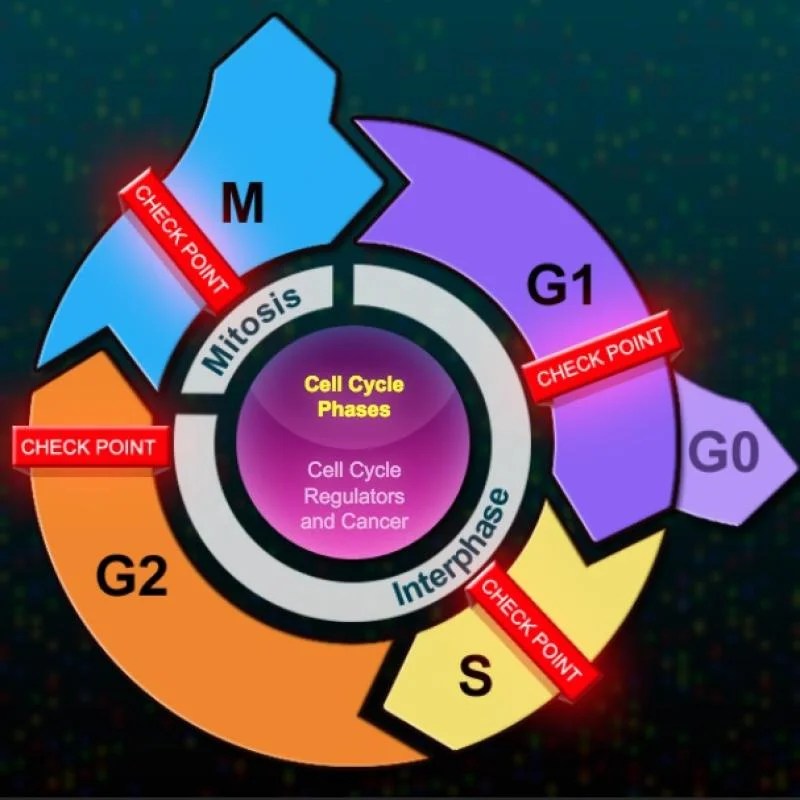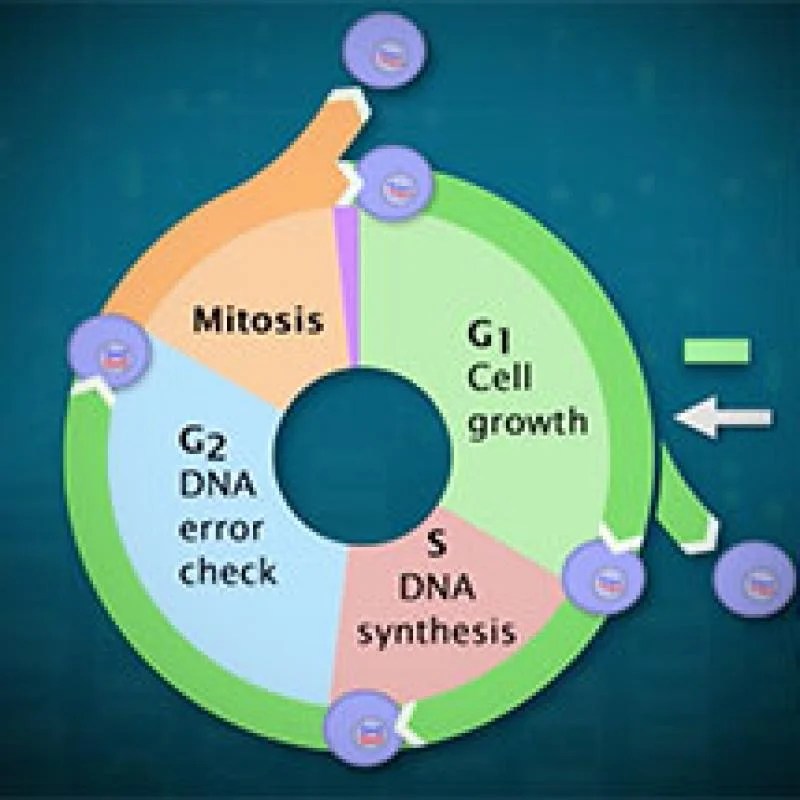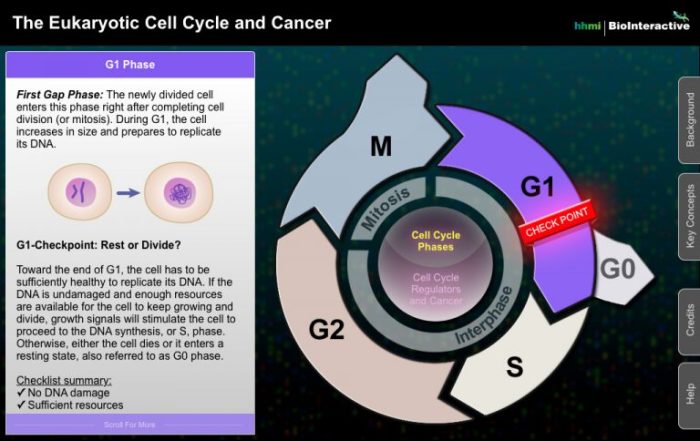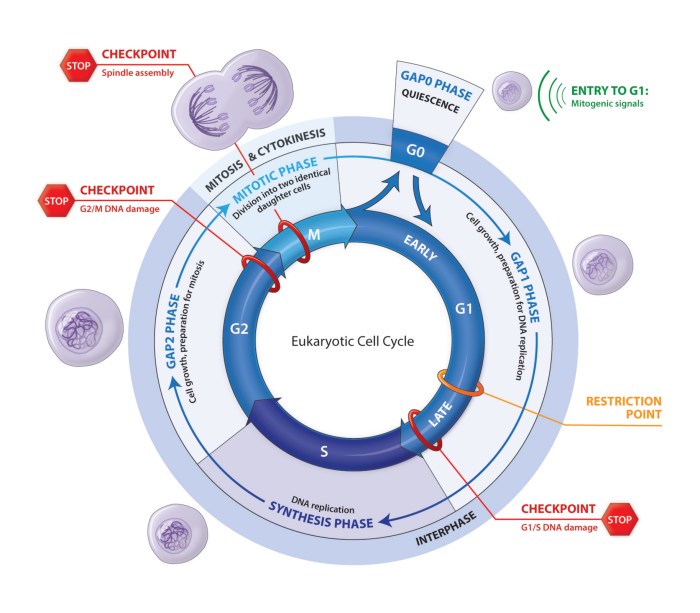The eukaryotic cell cycle and cancer answer unveils the intricate relationship between cell division and the development of cancer. This article delves into the stages of the cell cycle, the mechanisms that regulate it, and the consequences of dysregulation leading to cancer.
Understanding the cell cycle is crucial for comprehending the fundamental processes that govern cell growth and division. The eukaryotic cell cycle, a tightly controlled sequence of events, ensures the faithful duplication and distribution of genetic material to daughter cells.
The Eukaryotic Cell Cycle

The eukaryotic cell cycle is the process by which a cell grows and divides. It consists of four distinct stages: G1, S, G2, and M. During the G1 phase, the cell grows and prepares for DNA replication. In the S phase, the cell’s DNA is replicated.
During the G2 phase, the cell checks for errors in DNA replication and prepares for mitosis. Finally, in the M phase, the cell divides into two daughter cells.
Mitosis
Mitosis is the process by which a cell divides into two identical daughter cells. It consists of four stages: prophase, metaphase, anaphase, and telophase. During prophase, the chromosomes condense and the nuclear envelope breaks down. In metaphase, the chromosomes line up in the center of the cell.
In anaphase, the chromosomes are separated and pulled to opposite ends of the cell. In telophase, two new nuclear envelopes form around the chromosomes and the cell membrane pinches in the middle, dividing the cell into two daughter cells.
Cytokinesis
Cytokinesis is the process by which the cytoplasm of a cell is divided into two daughter cells. It occurs after mitosis and is completed by a process called cleavage furrowing. During cleavage furrowing, a ring of actin filaments forms around the center of the cell and contracts, pinching the cell membrane in the middle and dividing the cell into two daughter cells.
Checkpoints
Checkpoints are control points in the cell cycle that ensure that the cell is ready to proceed to the next stage. There are three main checkpoints: the G1/S checkpoint, the G2/M checkpoint, and the M checkpoint. The G1/S checkpoint ensures that the cell has grown enough and has all of the necessary nutrients to proceed to the S phase.
The G2/M checkpoint ensures that the cell’s DNA has been replicated correctly and that the cell is ready to proceed to mitosis. The M checkpoint ensures that the chromosomes are properly aligned and that the cell is ready to divide.
Cancer and the Cell Cycle

Cancer is a disease that is characterized by the uncontrolled growth and division of cells. This uncontrolled growth can be caused by mutations in genes that regulate the cell cycle. These mutations can lead to the loss of checkpoints, which allows cells to divide even when they are not ready.
This can lead to the formation of tumors, which are masses of abnormal cells.
Types of Cancer Cells
There are many different types of cancer cells, each with its own unique characteristics. Some of the most common types of cancer cells include:
- Carcinoma: Cancer cells that originate in epithelial cells, which are the cells that line the surfaces of organs and cavities.
- Sarcoma: Cancer cells that originate in connective tissue cells, such as bone, cartilage, fat, and muscle.
- Leukemia: Cancer cells that originate in blood-forming cells.
- Lymphoma: Cancer cells that originate in lymphocytes, which are a type of white blood cell.
Examples of Cancers Caused by Cell Cycle Dysregulation
There are many different types of cancer that are caused by cell cycle dysregulation. Some of the most common examples include:
- Lung cancer: Lung cancer is the leading cause of cancer death in the United States. It is caused by mutations in genes that regulate the cell cycle, such as the p53 gene.
- Breast cancer: Breast cancer is the most common cancer among women in the United States. It is caused by mutations in genes that regulate the cell cycle, such as the BRCA1 and BRCA2 genes.
- Colon cancer: Colon cancer is the third leading cause of cancer death in the United States. It is caused by mutations in genes that regulate the cell cycle, such as the APC gene.
Treatment Options for Cancer: The Eukaryotic Cell Cycle And Cancer Answer

There are many different treatment options for cancer, depending on the type of cancer, the stage of the cancer, and the patient’s overall health. Some of the most common treatment options include:
- Surgery: Surgery is used to remove tumors and other cancerous tissue.
- Radiation therapy: Radiation therapy uses high-energy radiation to kill cancer cells.
- Chemotherapy: Chemotherapy uses drugs to kill cancer cells.
- Targeted therapy: Targeted therapy uses drugs that specifically target cancer cells.
- Immunotherapy: Immunotherapy uses the patient’s own immune system to fight cancer.
How These Treatments Target the Cell Cycle
Many cancer treatments target the cell cycle. For example, radiation therapy and chemotherapy both work by damaging DNA, which can lead to cell death. Targeted therapy and immunotherapy both work by inhibiting the growth and division of cancer cells.
Examples of Specific Drugs or Therapies Used to Treat Cancer
There are many different drugs and therapies that are used to treat cancer. Some of the most common examples include:
- Doxorubicin: Doxorubicin is an anthracycline antibiotic that is used to treat a variety of cancers, including breast cancer, lung cancer, and leukemia.
- Paclitaxel: Paclitaxel is a taxane that is used to treat a variety of cancers, including breast cancer, lung cancer, and ovarian cancer.
- Trastuzumab: Trastuzumab is a monoclonal antibody that is used to treat breast cancer.
- Ipilimumab: Ipilimumab is a monoclonal antibody that is used to treat melanoma.
Research and Future Directions

Cancer research is a rapidly growing field, with new discoveries being made all the time. Some of the most promising new treatments for cancer are based on cell cycle research. For example, researchers are developing new drugs that target specific cell cycle proteins.
These drugs could be more effective than traditional chemotherapy drugs, which often have side effects that affect healthy cells.
Current State of Cancer Research
The current state of cancer research is very promising. Researchers are making great strides in understanding the biology of cancer and developing new treatments. This progress is leading to better outcomes for cancer patients.
New Technologies for Studying the Cell Cycle
New technologies are being developed all the time to study the cell cycle. These technologies are helping researchers to better understand how the cell cycle is regulated and how it is dysregulated in cancer.
Promising New Treatments for Cancer, The eukaryotic cell cycle and cancer answer
There are many promising new treatments for cancer that are based on cell cycle research. These treatments are being tested in clinical trials and are showing great promise for improving the outcomes of cancer patients.
Frequently Asked Questions
What are the key stages of the eukaryotic cell cycle?
The eukaryotic cell cycle consists of four main stages: G1, S, G2, and M (mitosis and cytokinesis).
How does uncontrolled cell division lead to cancer?
Uncontrolled cell division, a hallmark of cancer, occurs when cells bypass normal checkpoints and continue to divide uncontrollably. This leads to the accumulation of genetic mutations and the formation of tumors.
What are the different types of cancer cells?
Cancer cells exhibit a wide range of characteristics, including uncontrolled growth, evasion of apoptosis, and the ability to metastasize. Different types of cancer cells arise from different tissues and have unique molecular profiles.